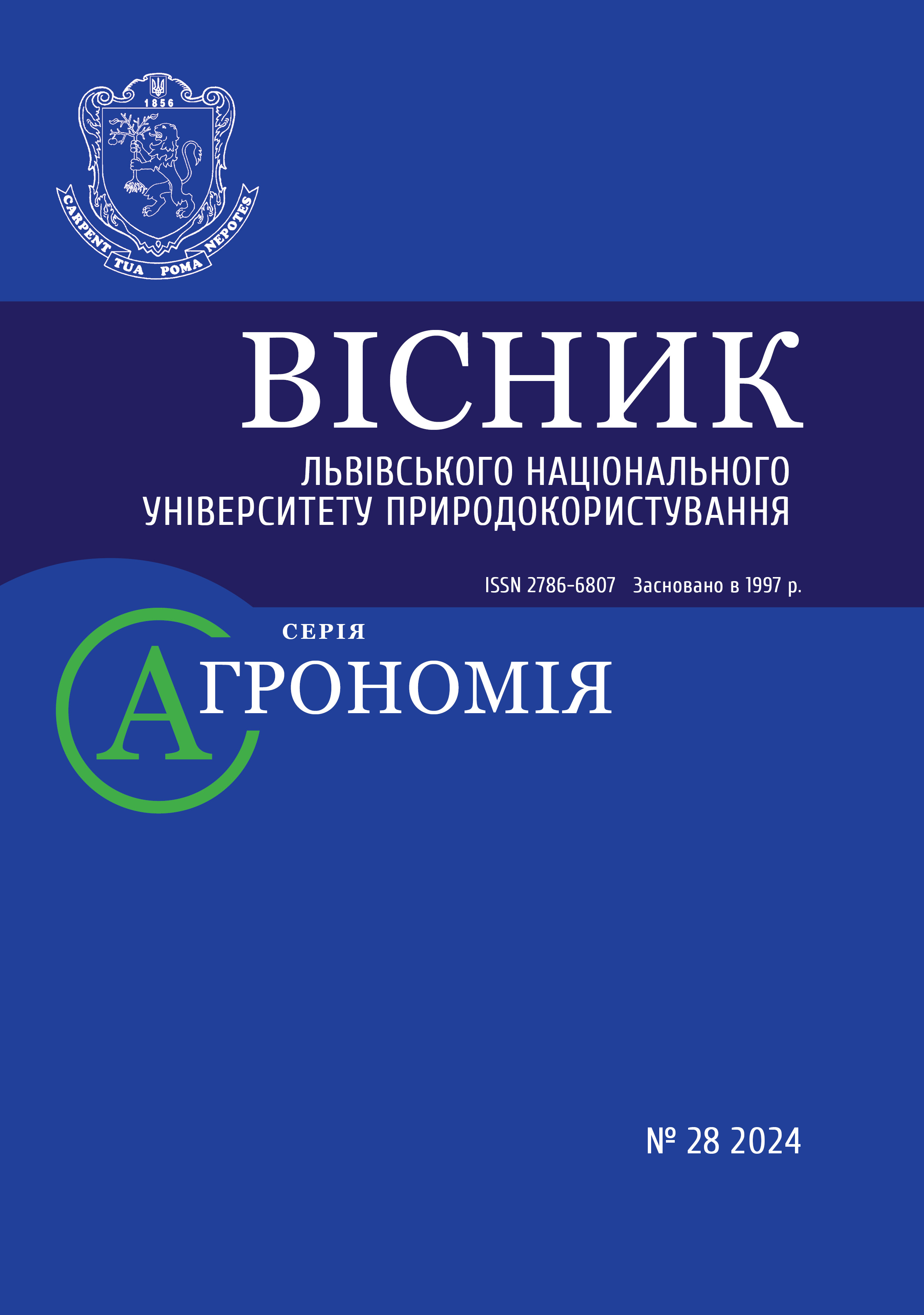УРОЖАЙНІСТЬ АМАРАНТУ ЗАЛЕЖНО ВІД СПОСОБУ СІВБИ В УМОВАХ ЛІСОСТЕПУ ЗАХІДНОГО
DOI:
https://doi.org/10.31734/agronomy2024.28.084Ключові слова:
амарант, спосіб сівби, структура врожаю, продуктивністьАнотація
Вивчено способи сівби амаранту сорту Лєра в умовах Лісостепу Західного на темно-сірому опідзоленому ґрунті. Погодні умови в роки досліджень були досить контрастними і відрізнялись від середньобагаторічних даних. У 2020 і 2022 роках середня температура за вегетаційний період становила 15,3 °С, що на 0,5 °С вище від багаторічних даних. У 2021 році вона (14,8 °С) відповідала середнім багаторічним даним. У 2020 році за вегетаційний період випало на 129 мм вище норми, у 2021 році – на 73 мм, у 2022 році – на 28 мм. У 2023 році нижча температура була у квітні та недостатньо опадів у травні, тоді як у червні та липні кількість опадів перевищувала середньобагаторічні дані на 24,4 та 31,7 мм відповідно.
Насіння висівали з міжряддями 15, 30, 45 та 60 см. Встановлено, що за різних способів сівби за однієї й тієї ж норми висіву формуються різні площі живлення однієї рослини. Так, за сівби з відстанню між рядками 15 см площа живлення була 15×25 см, і за таких умов на 1 м довжини рядка було чотири рослини з відстанню між ними 25 см. За міжряддя 30 см площа живлення становила 30×14 см, а на метрі рядка було сім рослин з відстанню між ними 14 см.
За ширини міжрядь 45 см ці показники змінювались до 45×10 см, десять рослин з відстанню між ними 10 см відповідно, а з міжряддями 60 см – 60×8 см, 13 рослин, 8 см. Густота рослин перед збиранням була в межах 22–24 шт./м2 і мало залежала від способу сівби. Рівномірніше розміщення рослин на площі і в рядку було за сівби з вужчими міжряддями. Найбільша маса насіння з рослини (17,8 г) була за сівби з відстанню між рядками 45 см. Урожайність насіння зерна амаранту сорту Лєра за сівби з міжряддями 15, 30 та 45 см була майже однаковою і коливалась у діапазоні 3,92–3,97 т/га. Найменшою врожайність у середньому за три роки була за сівби з міжряддями 60 см, де вона становила лише 3,70 т/га. Тобто за площі живлення у формі витягнутого прямокутника (60×8 см) та щільного розміщення рослин у рядку лише через 8 см складались несприятливі умови, що призвело до істотного зниження врожайності. За інших площ живлення і густоти рослин у рядку одержали майже однакові результати.
Посилання
Amaranth: selection, genetics and growing prospects: a monograph / Hoptsiy T. I. etc. Kharkiv: HNAU 2018. 362 p.
Bekhatskyi Yu. S., Antoniv S. F., Rudnytskyi B. O. The efficiency of growing panicled amaranth for seeds depending on fertilization and the width of the rows. Problems of cultivation, processing and use of amaranth for fodder, food and other purposes: the first All-Ukrainian science and practice. conf. Vinnytsia, 1995. P. 34.
Casini P., Biancofiore G. Influence of row spacing on canopy and seed production in grain amaranth (Amaranthus cruentus L.) Agronomy Research. 2020. No 18 (1). P. 53–62. https://doi.org/10.15159/AR.20.015.
Duda O., Kapshtyk M. Key elements of amaranth cultivation. Offer. 2021. URL: https://propozitsiya.com/ua/klyuchovi-elementy-tehnologiyi-vyroshchuvannya-amarantu (Accessed March 03, 2024).
Dudka M. I. Agrotechnological foundations of increasing the productivity of annual forage crops in the Northern Steppe of Ukraine: [Unpublished. extended. thesis Dr. Agr. Sciences]. National Acad. Agrarian of Sciences of Ukraine, State Institute of grain cultures, 2020.
Dudka M. I. Cultivation of panicled amaranth (Amaranthus paniculatus) in the conditions of the northern steppe of Ukraine. Cereal crops. 2019. Vol. 3, No 1. P. 52–61. https://doi.org/10.31867/2523-4544/0060.
Dudka M. I. The influence of the method of sowing, the rate of sowing and the level of mineral nutrition on the productivity of paniculate amaranth. Horticulture and soil science. 2020. No 11 (1). P. 23–32.
Effect of levels of nitrogen and iron on yield of grain amaranth (Amaranthus hypochodriacus L.) under different planting techniques. Agricultural Science Digest, Patel K. I., Patel B. M., Patel S. J. Et al. 2012. No 32 (3). P. 193–198.
Hudkovska N., Hoptsii T. Yield of amaranth grain depending on the terms and methods of sowing in the conditions of the left-bank forest-steppe of Ukraine. Bulletin of Kharkiv National Agrarian University. Series “Plant growing, breeding and seed production, fruit and vegetable growing and storage”. 2018. Issue 2. P. 112-124.
Husiev M. H., Voitashenko D. P. Productivity of grain amaranth depending on the method of sowing and the rate of sowing. Irrigated agriculture. 2006. No 46. P. 109–112.
Kohut S. H. Optimizing measures of the amaranth sowing complex in the conditions of the southern Steppe: Unpublished. extended thesis Dr. Agr. Sciences. Kherson, 2006. 16 p.
Mishyn S. M., Kohut S. H., Kohut I. M. Mathematical interpretation of the dependence of amaranth seed yield on sowing density. Coll. of science Agrarian Bulletin of the Black Sea Coast. Odesa. 2011. No 57. P. 124–130.
Rotich A. N., Gweyi-Onyango J. P., Korir N. K. Diagonal offset arrangement and spacing architecture effect on growth and yield components of grain amaranth in Kenya. Asian Res. J. Of Agric. 2017. No 6 (1). P. 1–8. https://doi.org/10.9734/ARJA/2017/35312.
Rudyshyn V. K. Ways of sowing hairy amaranth. Problems of cultivation, processing and use of amaranth for fodder, food and other purposes: the first All-Ukrainian science and practice. conf. Vinnitsa. 1995, P. 48.
Shelest V. K., Pidpalyi I. F., Bernadskyi I. V. Seed sowing rate, row width and sensitivity to irrigation of amaranth panicle in the Central Forest Steppe. Problems of cultivation, processing and use of amaranth for fodder, food and other purposes; the first All-Ukrainian science and practice. conf. Vinnitsa, 1995. P. 40–41.
Tyrus M., Lykhochvor V. Yield of Amaranth (Amaranthus) depending on the cultivar in the conditions of Ukrainian Western Forest-Steppe. Scientific Horizons. 2021. No 24 (10). P. 43–51. https://doi.org/10.48077/scihor.24(10).2021.43-51.
Vasylieva Yu. V. Stankevych S. V. Prospects of amaranth cultivation in Ukraine and optimization of its chemical protection against harmful organisms. Agriculturist. No 4 (335). P. 22–23.


